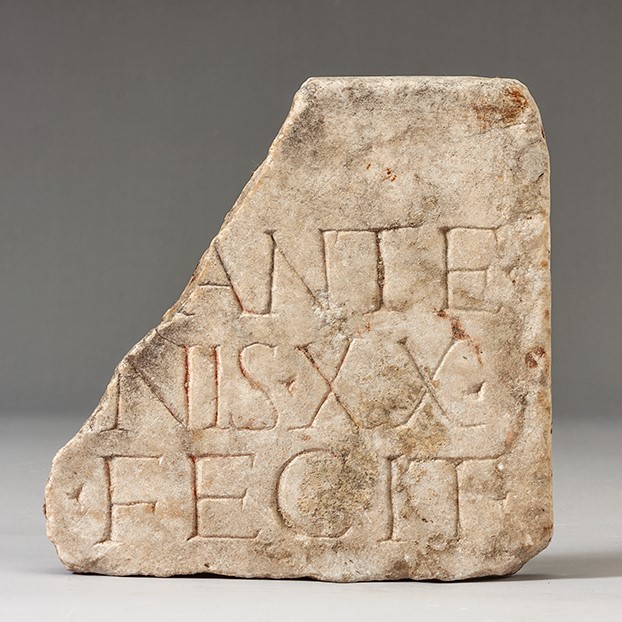Acquisition number: 2002.12
Dull white, fairly dense marble, smooth on the front, partially smoothed on the back but with some areas left slightly rougher. On the vertical edge at the back is a cutting for an older clamp: the piece was probably re-used. There is red lead highlighting in the letters. Fairly fine lettering, clearly cut, with serifs of varying size at tops and bottoms of the strokes. There are small ivy-leaves as word-dividers (the so-called hedera distinguens)
…]ANTE.
.AN]NIS.XX.
…].FECIT
Title: Fragment of an Inscription on Marble - 2002.12
Acquisition number: 2002.12
Author or editor: J.R. Green
Culture or period: Roman Imperial
Date: 1st - 2nd century AD.
Material: Stone - Marble
Object type: Inscriptions - Funerary
Dimensions: 27mm (l) × 147mm (w) × 147mm (h)
Origin region or location: Italy
Origin city: Ostia.
Display case or on loan: 6
Keywords: Roman, Imperial, Funerary, Inscription, Anteros, Ostia
Unpublished.
2002.12
Fragment of an Inscription on Marble
Presented by Emeritus Professor Paul Weaver; from Ostia. Ht 14.7cm; max. pres. width ca 14.7cm; thickness 2.7cm.
Dull white, fairly dense marble, smooth on the front, partially smoothed on the back but with some areas left slightly rougher. On the vertical edge at the back is a cutting for an older clamp: the piece was probably re-used. There is red lead highlighting in the letters. Fairly fine lettering, clearly cut, with serifs of varying size at tops and bottoms of the strokes. There are small ivy-leaves as word-dividers (the so-called hedera distinguens)
…]ANTE.
.AN]NIS.XX.
…].FECIT
Note that there is space for another line of lettering at the top that one may guess was DM, placed at the centre. It is likely that it was a funerary inscription although the location at Ostia is not recorded. From what remains, one could expect that the name of the deceased was given in the first extant line, and that we were then told that he lived 20 years (and perhaps some months), and then in the bottom line the name of the person who had the stone inscribed and the grave made (fecit).
The cognomen of the deceased is most likely to have been Anteros, in the genitive such as one would expect here Anterotis, so that the second line would have begun with ROTIS.
There is an excellent study of such inscriptions from Ostia by H. Thylander, Inscriptions du Port d’Ostie, i-ii (Lund 1952). One should also see the cautionary remarks of R. Meiggs, Roman Ostia (Oxford 1960) 554-557 (Appendix X: the Dating of Ostian Inscriptions). For a very useful general picture, see L.B. van der Meer, Ostia Speaks: Inscriptions, Buildings and Spaces in Rome's Main Port (Leuven 2012).
First – second century AD, probably Hadrianic.
Unpublished.
